
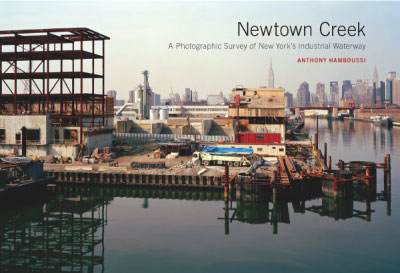
Photography by Anthony Hamboussi. Courtesy of Princeton Architectural Press


As we grow more and more distressed by the oil spill in the Gulf of Mexico, it’s a good time to remember Newtown Creek, a similarly devastated body of water that runs right through Brooklyn and Queens. Once teeming with plant and animal life, the creek was polluted by decades of industrial dumping, and by the gradual leakage of 17 million gallons of oil from underground storage tanks. More than ninety-five acres of water and land were spoiled. Although a clean-up was undertaken in the 1990’s, the area remains too toxic for conventional development and was recently added to the EPA’s Superfund National Priorities List.
Brooklyn-based photographer Anthony Hamboussi traveled the length of the creek from 2001 to 2006 to compile
Newtown Creek: A Photographic Survey of New York’s Industrial Waterway. His images poignantly capture the remains of what was once a thriving industrial culture. Waterfront plots are built up with factories, warehouses, silos, smokestacks, and shipping piers, many abandoned and in disrepair. The creek itself is visible only in low, dark stretches, frozen in the winter and fetid in the summer. It looks more like a sewer than a natural body of water. Some factories along the shores remain active, but the only signs of natural life are weeds sprouting up through the paving.
(more…)
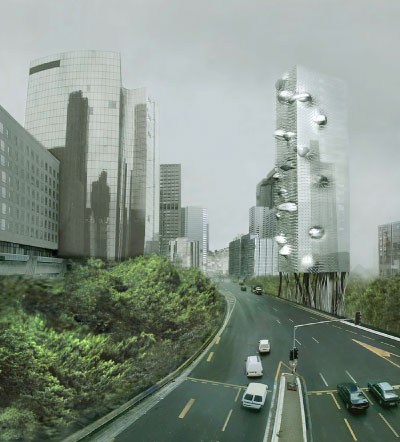
(un)plug, design for an office tower in Paris

Green thinking is changing the way we build. We’re reusing existing structures and materials, designing more efficient building systems, and thinking about long-term sustainability. But these changes are minor in view of the far deeper changes to come, as ecologically-minded designers reexamine their most fundamental assumptions about a door and a roof and a foundation, and reimagine what a building is entirely.
The visionary French architecture office R&Sie(n) is right at the forefront. Its projects, collected in the book Bioreboot: The Architecture of R&Sie(n), offer an architecture that’s deeply enmeshed with natural forces, and entirely liberated from modern conventions about design and construction.
Since the mid-nineteenth century, when steel framing supplanted heavy masonry construction, buildings have been conceived as stable shells that shaped efficient interior environments, as machines for living. R&Sie(n) complicates this paradigm. Its buildings aren’t discrete, unchanging objects but mutable devices embedded within ecologies of weather, time, geology, flora, and fauna.
(more…)

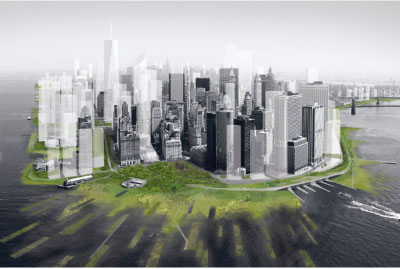
ARO and dlandstudio, section showing green infiltration streets.


We move through New York City largely unconscious of the bodies of water that surround us. Our neighborhoods turn inward, onto streets and parks. Even when we’re on the waterfront our rivers and inlets remain lovely backdrops; we don’t fully understand the forces that move them and the life they support.
In fact the city’s sea level is rising due to global warming, and could be nearly two feet higher fifty years from now. This would endanger much of the city’s existing waterfront, overloading sewers and eroding foundations. The curators of Rising Currents: Projects for New York’s Waterfront, on display now at MoMA through October 11, selected five regions of the waterfront that are particularly vulnerable and asked five local design teams for their solutions.
Their vivid proposals all highlight “soft infrastructure”, that is, broadly-based ecological interventions rather than purely structural ones. So instead of wrapping the shorelines in a concrete super-wall, the teams employ inventive planning, planting, and building to meet the challenge.
Somewhat audaciously, three of the five schemes continue building the city out over the water. ARO and dlandstudio extend the tightly-woven fabric of downtown Manhattan outward, building porous streets from an engineered mesh of concrete and seawater plants.
(more…)

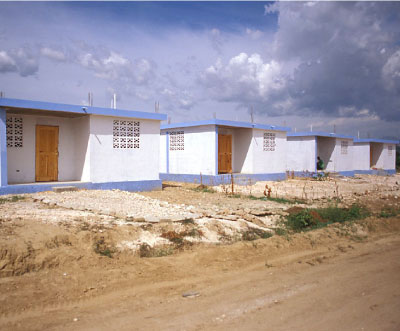
A Core House for Haiti, by Habitat for Humanity


The numbers are numbing. The January 12 earthquake in Haiti left approximately 1.2 million people homeless, 600,000 of them in the capital city of Port-au-Prince. As the rain and hurricane season begins this month many are still living in shelters constructed from scrap wood and tarps, in informal settlements without adequate power and sanitation.
While the Haitian government oversees long-term redevelopment, private and non-governmental agencies (NGO’s) are taking the lead to provide housing. Some are focusing on overarching strategic work, using their expertise to support other organizations. Architecture for Humanity has developed open-source guidelines for rebuilding, established Community Resource Centers to support NGO builders in the field, and is planning to rebuild schools. The San Francisco based organization Build Change has established simple technical standards for earthquake-resistant construction to guide local and NGO builders.
Many NGO’s are working directly to put up housing. The initial drive is to provide temporary shelters so that people can survive the hurricane season. Teams are searching for quick and economical solutions to help the greatest number of people. Habitat for Humanity began its relief work by distributing thousands of emergency kits packed with twine and tarps to the country. A Home in Haiti, an Atlanta organization that ships camping tents purchased by individual donors directly to the country, has intensified its outreach in recent weeks to beat the impending storms.
(more…)
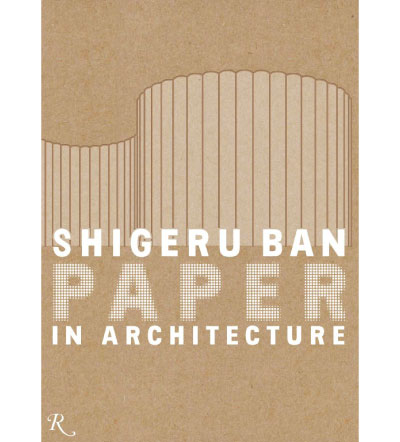
All images courtesy of Rizzoli, from Shigeru Ban: Paper in Architecture

There are great architects who work with established conventions, elevating them masterfully. And there are great architects who work without regard to conventions, establishing their own way of building. Shigeru Ban is this kind of architect. His innovative structures employ industrial cardboard tubes as structural framing elements. Collected in last year’s book Shigeru Ban: Paper in Architecture, these projects seem especially meaningful right now, as we rebuild after earthquakes in Haiti and Chile and search for an architecture that’s practical, inexpensive, and beautiful.
Like Frank Gehry houses of exposed wood studs and plywood, and Tadao Ando’s buildings in poured concrete, Ban’s structures take an everyday building material and transform it with ingenuity and grace. Ban has studied these tubes for decades, working closely with engineers and lawmakers in Japan to establish standard construction methods, details, and metrics. He single-handedly advanced their technology and developed their vocabulary, one that’s on the verge of a new kind of architecture.
(more…)

All photographs © Todd Selby, from The Selby is In Your Place by Abrams.

TheSelby.com has been a must-visit since its launch in 2008. Followers the world over click on regularly to see which artists, designers, performers, and style-makers have been most recently anointed, pictured in their living and working spaces by New York based photographer Todd Selby. Now Selby has compiled some of his best photo essays, along with the watercolor illustrations and hand-written questionnaires that accompany them, in one volume, The Selby is In Your Place.
Since the website’s launch he’s been inundated by requests from viewers to visit them and photograph their homes. In an email conversation, Selby explained that he typically finds new subjects through recommendations from friends. In addition, he does extensive research before visiting artists’ homes to ensure that their decorative sensibility will suit his own, which clearly tends toward excess. As he states: “Minimalism is boring. Maximalism is exciting.”
Selby’s photographs have tapped into a brand of interior design that has long been associated with artistic and bohemian living, one in which the home becomes a backdrop for a dense, eccentric, artfully curated display of personal possessions. Selby himself grew up in the suburbs of Orange County, California. ”Our house had tons of funny stuff we had collected from our travels,” he remembers. Similarly, the interiors that he’s drawn to are encrusted with their owners’ things: found objects, momentos, talismans, artwork, and antiques. They’re at once immensely stylish and intensely personal.
(more…)
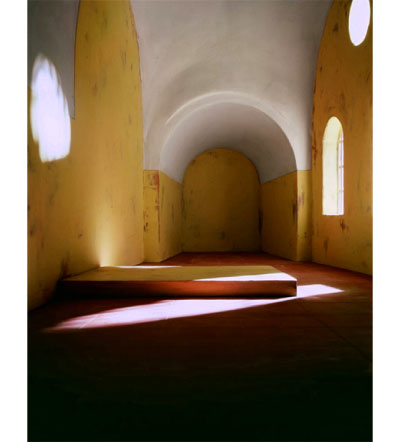
Luxor #3, 2007, James Casabere. All images by © James Casebere Courtesy: Sean Kelly Gallery, New York

Most of the works at the 2010 Whitney Biennial, on view now through May 30, are mixed-media pieces that have strong ties to performance art, combining elements of installation, dance, music, theater, and video. One featured artist whose work falls far from these categories is photographer James Casebere. Amid the visual and literal noise of the exhibit, his two giant digital chromogenic prints, each about six feet by eight feet, possess a classical stillness and quiet subversiveness.
For more than thirty years Casebere has constructed scaled paper models of existing buildings and photographed them from naturalistic points of view, in the same way that an architectural model-maker would. While an architect constructs models to anticipate what a structure will be, Casebere commemorates what a structure has been. In the structures he chooses to commemorate, and in the tone of the commemoration, his work offers pungent political references. He has based works on contemporary American prisons, European mosques, Caribbean plantations, and the Reichstag. The models in many of his recent photographs depict darkly-lit basement spaces flooded with water, images with nightmarish, apocalyptic overtones.
At first glance the two photos on display at the Biennial, Landscape with Houses (Dutchess County NY) #1″ and “#2,” seem cheerfully apolitical.
(more…)
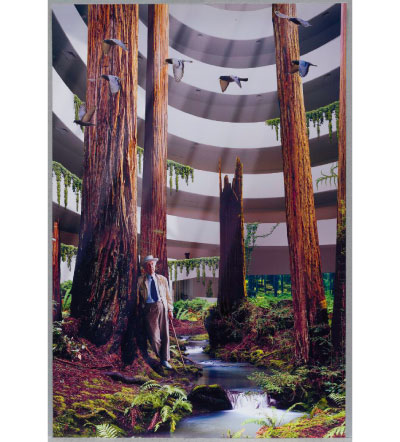
Saunders Architecture, FLW in His Element, 2009 All images courtesy Guggenheim Museum.

In conjunction with its 50th anniversary the Guggenheim Museum sponsored a design challenge, inviting almost 200 artists, designers, and architects to propose treatments for the signature spiraling atrium of its Frank Lloyd Wright building. The collection of proposals, Contemplating the Void: Interventions in the Guggenheim Museum, is on view now through April 28, and also posted on the museum’s website. The show offers a compelling snapshot of contemporary design currents, particularly of green building strategies.
The entries, and the media in which they’re presented, are impressively diverse. There are crayon drawings, watercolors, and pencil sketches, laser-cut models and computer renderings. The most straightforward proposals place one object within the building’s enormous central space. Different designers propose a chandelier, a hot air balloon, a column of water, a cloud of pigment, an oil rig, and the body of an Airbus A380. The more tectonic proposals, which respond to the space’s forms and circulation, are less inspired. Many designers install mirrors to distort perceptions of the space, build interconnecting passages within the space, and extend the existing curving ramp upwards, downwards, and outside the shell of the building.
(more…)
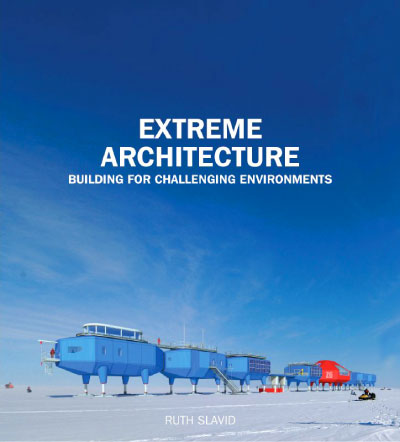
Published by Laurence King.

Here’s a book from last year that slipped under our radar: Extreme Architecture: Building for Challenging Environments, by Ruth Slavid. It’s a compilation of contemporary structures that were designed in response to extraordinary environmental conditions (heat, cold, water, altitude, and outer space) and less directly in response to aesthetics.
Some of the projects, such as a ski jump by Zaha Hadid and a spa by Mario Botta, are self-consciously avant-garde and others, such as snow sheds and desert schools, are fundamentally utilitarian. Yet all, as they turn to meet the challenges of the environment, unsettle expectations of what a building should look like. They don’t simply fall into fashion.
Rather than sit upright on the ground, as conventional buildings do, those in hot and windswept climates tend to burrow beneath it, and those in wet and high climates tend to leap away from it. The buildings are similarly polarized in appearance, evoking either prehistoric or futuristic styles. A hotel in Patagonia, finished in roughly hewn wood and sunk into the earth, resembles a neolithic ruin. A giant drum-shaped workstation in Antarctica, hovering on squat steel legs, looks like a science fiction stage set. Many of the structures have an animated quality, as if they’re creatures who’ve undergone evolutionary mutations and adaptations. A cultural center in British Columbia, Canada lies camouflaged within the scrubby landscape. A ski jump in the Alps lifts its head above adjacent peaks like a brontosaurus.
(more…)
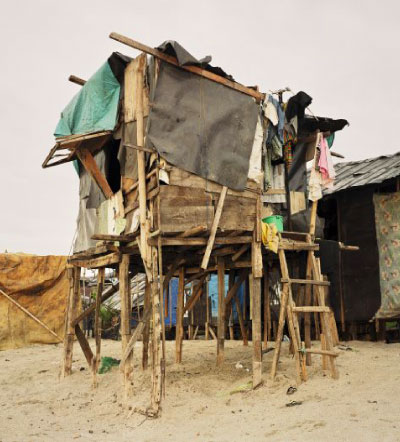
All Photography by Peter Bialobrzeski, courtesy of Hatje Cantz.

Peter Bialobrzeski’s photographs of houses in the informal community of Baseco, Manila, might be especially relevant right now. The small, tilting, wood-framed homes in these pictures, sealed with scraps of fabric, plastic tarps, and posters, are vivid expressions of vulnerability and determination. They remind one of the emergency conditions in Haiti, where thousands of people are currently living in similarly constructed makeshift shelters and, because of cyclical poverty and challenges in rebuilding, could remain indefinitely.
The collection’s title, “Case Study Homes”, refers ironically to the Los Angeles Case Study Houses of the 1950s, a series of modernist prototypes documented in coolly glamorous photographs by Julius Schulman. Bialobrzeski’s photographs don’t have that gloss, of course, but they possess a stately formal beauty that confers dignity on the houses. A diffuse tropical light mutes vivid colors and shadows to give the images a silvery, etched appearance, like Walker Evans’ Depression-era photos. While Evans looked straight into his subject’s faces, however, Bialobrzeski only examines the outside of their homes, a strategy that steers clear of sentimentality. These photographs give straightforward testimony.
(more…)







 Facebook
Facebook Permalink
Permalink Digg
Digg Reddit
Reddit LinkedIn
LinkedIn StumbleUpon
StumbleUpon Tumblr
Tumblr












